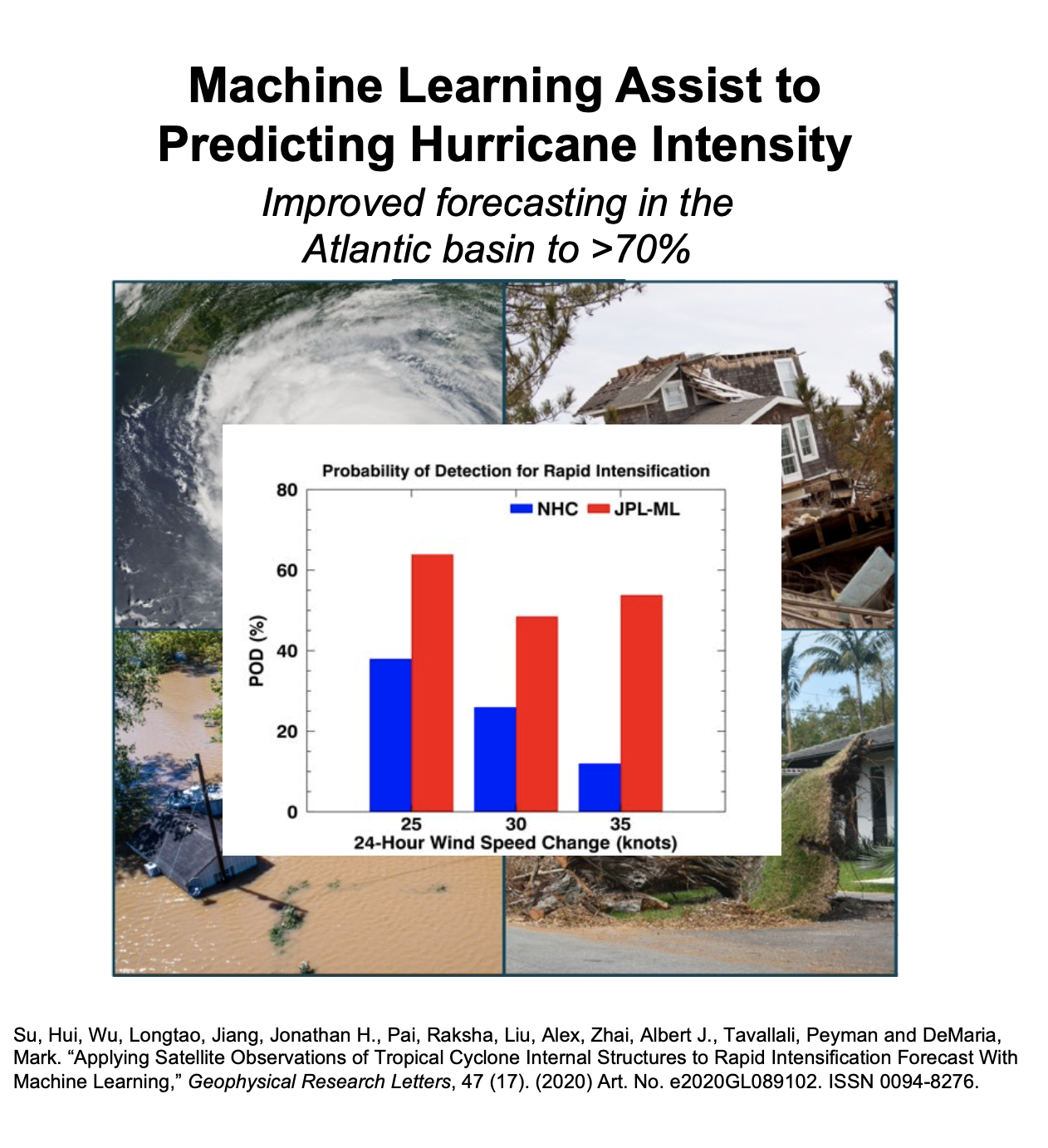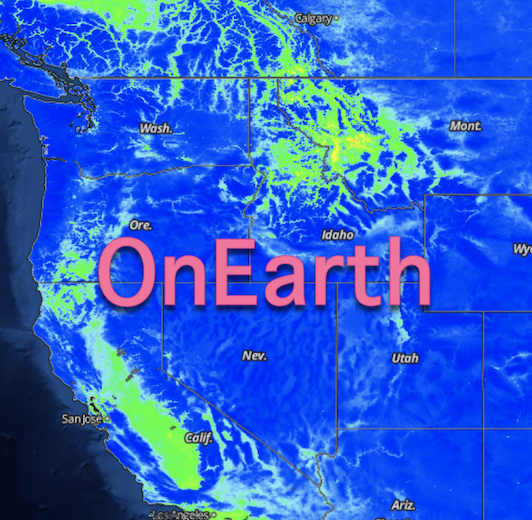Mission Statement
IDEAS aims to provide virtual representations of the physical environment by continuously onboarding new observations and model outputs to improve our understanding of Earth systems and provide decision support through analysis of hypothetical scenarios. IDEAS is an architectural approach for building software systems that will help us better understand Earth's systems and inform decisions that affect the future of the planet. Current IDEAS prototype implementations include analysis and prediction for air quality and flood events.
The IDEAS project is supported via NASA’s Earth Science Technology Office by the Advanced Information Systems Technology (AIST) program. It is especially relevant to AIST’s Earth System Digital Twin (ESDT) focus area, in which ESDT is defined as an “interactive and integrated multidomain, multiscale, digital replica of the state and temporal evolution of Earth systems.” As described by AIST, ESDTs allow users to interact with a digital replica for a domain of interest to answer questions such as “what now?”, “what next?”, and “what if?” More information about Earth System Digital Twins can be found on the AIST ESDT web page.
IDEAS is one architectural approach that provides components to develop and explore architectures for Digital Twins. The IDEAS architecture orchestrates models and data to enable Digital Twin capabilities. It provides mechanisms for the outputs of one model to feed into others; for driving models with observation data; and for harmonizing observation data and model outputs for analysis. To demonstrate and validate this architecture, the IDEAS architecture has been implemented for two applications.

Explore IDEAS Applications
Develop with IDEAS APIs


Root URL
https://ideas-digitaltwin.jpl.nasa.gov/nexus
List Datasets
Endpoint: /list
Description: Provides a list of available data sets.
Output Type:
JSON
Example Call:
https://ideas-digitaltwin.jpl.nasa.gov/nexus/list
Spark Time Series
Description: Computes time series statistics
Endpoint: /timeSeriesSpark
Output Type: see output parameter.
Query Parameters:
| Parameter | Required | Description |
|---|---|---|
ds |
required | The dataset on which to generate the statistics.
e.g. one of shortName value as supplied
by
the /list endpoint.
|
b |
required | Bounding box Minimum (Western) Longitude, Minimum (Southern) Latitude, Maximum (Eastern)
Longitude, Maximum (Northern) Latitude.
e.g. -60.0,10.0,-45.0,30.0
|
startTime |
required | Starting time in format YYYY-MM-DDTHH:mm:ssZ or seconds since EPOCH.
e.g. 1453072400
|
endTime |
required | Ending time in format YYYY-MM-DDTHH:mm:ssZ or seconds since EPOCH.
e.g. 1463072400
|
seasonalFilter |
optional | Flag used to specify if the seasonal averages should be computed during Time Series
computation.
e.g. False
|
lowPassFilter |
optional | Flag used to specify if a low pass filter should be computed during Time Series computation.
e.g. False
|
spark |
optional | Configuration used to launch in the Spark cluster.
Value should be 3 elements separated by commas. 1) Spark Master 2)
Number of Spark Executors 3) Number of Spark Partitions. Only Number of
Spark Partitions is used by this function.
e.g. local,4,8
|
output |
optional | Data formatting for results. Default is JSON. Alternative is
CSV for comma-seperated values.
|
Spark Average Daily Difference
Description: Computes anomalies for a specified region over a specified timeframe.
Endpoint: /dailydifferenceaverage_spark
Output Type:
JSON
Query Parameters:
| Parameter | Required | Description |
|---|---|---|
dataset |
required | The dataset on which to calculate anomalies. One of shortName value as supplied by the /list endpoint.
e.g. AVHRR_OI_L4_GHRSST_NCEI
|
climatology |
required | The dataset climatology used to calculate anomalies. One of shortName value as supplied by
the /list endpoint.
e.g. AVHRR_OI_L4_GHRSST_NCEI_CLIM
|
b |
required | Minimum (Western) Longitude, Minimum (Southern) Latitude, Maximum (Eastern) Longitude,
Maximum
(Northern) Latitude.
e.g. -170,-5,-120,5
|
startTime |
required | Start time in which to calculate anomalies, in format YYYY-MM-DDTHH:mm:ssZ or seconds since
EPOCH (Jan 1st, 1970).
e.g. 1291190400
|
endTime |
required | End time in which to calculate anomalies, in format YYYY-MM-DDTHH:mm:ssZ or seconds since
EPOCH (Jan 1st, 1970).
e.g. 1462086000
|

Web Map Tile Service (WMTS)
Sample imagery not included.
Root URL
https://ideas-digitaltwin.jpl.nasa.gov/wmts
Endpoints
/status
Description: Check OnEarth WMTS is running.
/epsg4326
Description: EPSG geographic projections.
Demo call:
https://ideas-digitaltwin.jpl.nasa.gov/demo/wmts/epsg4326/
/epsg3857
Description: EPSG webmercator projections.
Demo call:
https://ideas-digitaltwin.jpl.nasa.gov/demo/wmts/epsg3857/
/epsg3413
Description: EPSG arctic projections.
Demo call:
https://ideas-digitaltwin.jpl.nasa.gov/demo/wmts/epsg3413/
/epsg3031
Description: EPSG antarctic projections.
Demo call:
https://ideas-digitaltwin.jpl.nasa.gov/demo/wmts/epsg3031/
Sample Requests
GetCapabilities Request:
Tile Request:
Web Mapping Service (WMS)
Root URL
https://ideas-digitaltwin.jpl.nasa.gov/wms
Endpoints
/status
Description: Check OnEarth WMS is running.
/epsg4326
Description: EPSG geographic projections.
/epsg3857
Description: EPSG webmercator projections.
/epsg3413
Description: EPSG arctic projections.
/epsg3031
Description: EPSG antarctic projections.
Sample Requests
GetCapabilities Request:
Tile Request:
